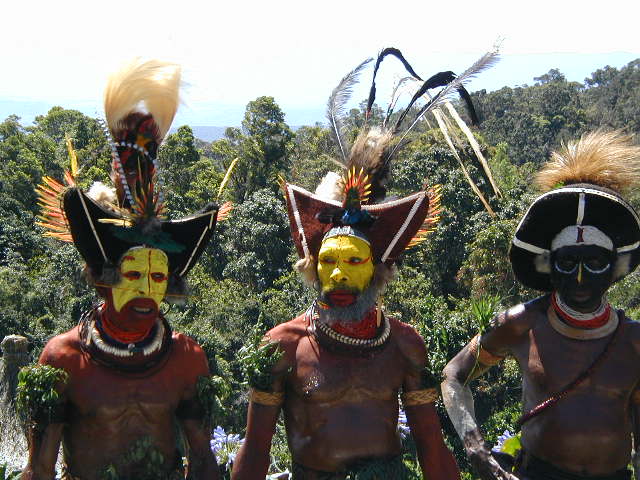
We would get to learn a lot more about the Huli people during our three days at Ambua Lodge. First, though, we had to get there. We were originally supposed to fly to Tari and go to Ambua by bus. However, there was an outbreak of violence in Tari (a mixture of election related tension, long standing tribal warfare and general opportunism by "raskols") and it was deemed inadvisable to go there. So Trans Niugini Tours made alternate arrangements. First, we were to fly to Mendi. From there, we would go to Ambua by helicopter. The first part was straightforward enough as there was enough room in the Southwest Air Twin Otter for the whole group. We then shuttled to Mendi in five passenger helicopters. (It was more than the 11 of us, by the way. There was a Japanese film crew and another group of four who were essentially on the same itinerary as us.)
I was on the last helicopter and got a good story out of it. First, I should explain my use of the term "raskol" above, though. In standard English, "rascal" is a rather innocuous term, implying nothing beyond mild mischief. But in Pidgin, "raskol" means a criminal or bandit and is decidedly not benign. No, we didn't have a direct encounter with one. Instead, we had to wait while the police commandeered our helicopter to go after a raskol who had stolen the police car! They did catch him, by the way.
Ambua Lodge is a lovely setting - a bunch of thatched roof huts climbing the hillside to a large central building. We started our visit there with a mumu lunch - chicken and vegetables cooked in a fire pit. While the leaves lining the pit seemed authentic enough, I suspect that the aluminum foil around the food is not quite traditional. Lunch was followed by a performance of a Huli sing-sing, which was pretty much like the Huli groups we'd seen in Mount Hagen. The one thing to note is that the man whose face is painted black is from a different village than the others. He's also wearing an everyday wig, while the other two men are wearing the wigs that are used for special events.

We hadn't seen spirit dancers, before though. This dance is traditionally done at night and is a healing dance. My notes are sketchy, but the general concept has to do with scaring away evil spirits.
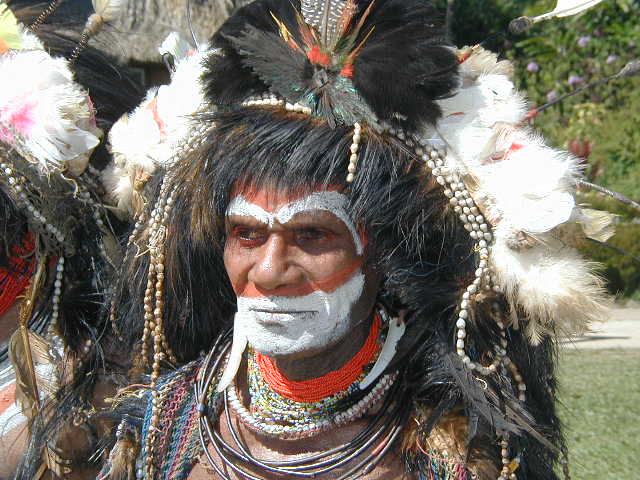
We had a talk by a Huli woman about the women's role. Her lecture was, in general, consistent with what Carolyn had told us previously. One of the more interesting things she added had to do with taboos regarding menstruation. For example, at her first period, a girl is set off in a small house by herself. There's also a belief that men will be poisoned if they eat food cooked by a menstruating woman. In general, the women live a difficult life and it is not very surprising that the divorce rate is very high.
That talk was followed by one about weapons and warfare. Compensation or "payback" is central to the highland lifestyle. For example, if a boy talks to a girl he isn't related to, he has to either marry her (which includes paying bride price) or pay compensation. There is also compensation for killing in warfare, paid in three stages. The killing continues until all the compensation is paid off. For example, Harold (the lecturer) said his clan and another have been fighting since September 2000 and he has been unable to go home for two years because he would have to pass through enemy territory. By the way, the war started because a girl went to a disco and was raped. But it continues because of the payback system.
One of the luxuries at Ambua is 24 hour electricity, thanks to hydroelectric generators. That meant electric blankets to keep us warm during the chilly highland nights. It also meant nightly videos. The first night featured "First Contact." This is the story of the Leahy brothers, who were the first Europeans to reach the New Guinea highlands - in 1930. The film interposes footage shot by the Leahy brothers with interviews with local people who'd met them. One amusing part was the reaction of the highlanders to a gramophone. They thought the recorded music was the voices of their ancestors. Overall, it was an interesting film, though the Leahys don't come across as very likeable.
There was optional early morning bird watching, but neither early mornings nor birds are things I'm all that crazy about. Our regular tourism program involved a series of village visits. The road was fairly bad, though not the worst I've been on by any means. Our first stop was at Mister Honarapa's village. (I'm not positive that I got the name down correctly, but I'm close.) First, we visited the men's house, which was very smoky inside. We also had a demonstration of fire making and saw how the men smoke using a sort of cigarette holder.
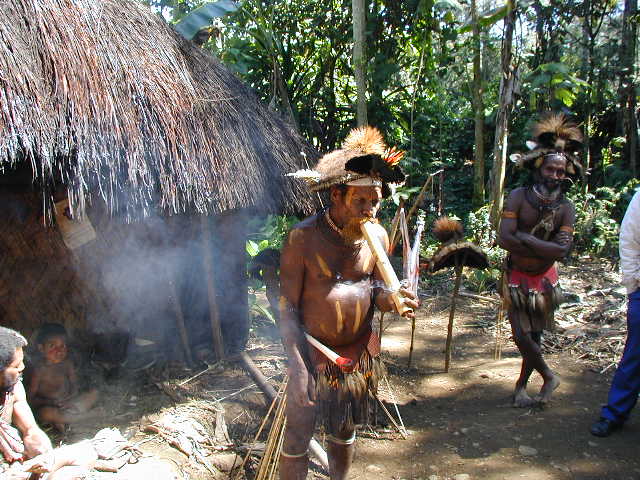
We walked through the men's gardens and on to the women's house, where we saw how they make grass skirts. The bottom end of the grass is soaked in mud to turn it a dark color. The effect is quite attractive, but I doubt I'll be adopting it anytime soon.
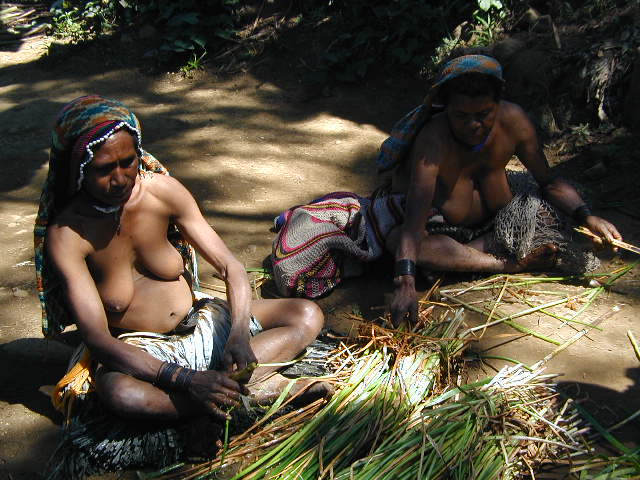
We had an archery demonstration, too. The bow is apparently a strong draw and neither of the men from our group who tried it were terribly successful. Then we got back on the bus and went to another village, where we saw a reenactment of a wedding. The biggest part of it had to do with showing off the pigs for the bride price. The mother of the bride had a dispute with the eldest son over how to divide the bride price between them. This was quite humorous, with her throwing kina shells at him and demanding pigs. The bride just got to stand idly by, wearing bilums on her head and chest. (In the end, the village headman ruled in favor of the mother and she got the pig.)
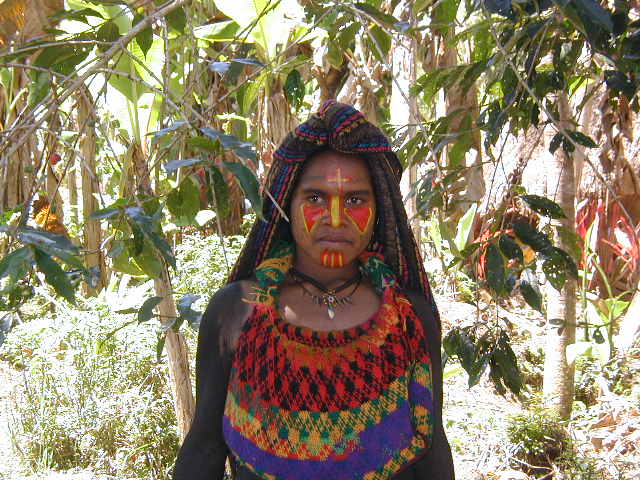
We had a picnic lunch at another homestead before seeing a recreation of how widows are treated. The widow has to paint her face with clay and is surrounded by guards to keep her from committing suicide. She carries all her husband's belongings in a bilum. She can only wash off the clay if she remarries or returns to her father. She may also cut off some of her fingers, though this practice is more closely associated with regions further west (e.g. in Irian Jaya, the Indonesian part of the island).
On the way back to the lodge, we stopped at a market. The most common things for sale were sweet potatoes and tobacco. The mix of traditional and Western attire was particularly interesting. For example, I saw men wearing baseball caps decorated with flowers and feathers. I also noticed a woman wearing a grass skirt and a polo shirt.
The after dinner video was "Richard Attenborough in Paradise." The birds of paradise are pretty bizarre, while the bower birds look plain but build complicated bowers to attract their mates. That may be interesting, but I still wasn't going to get up at 5:30 in the morning to go birding. I did see a lovely bird that I think was some sort of sicklebeak just off the path on my way down to breakfast in the morning.
I had a cold and, between that and the altitude, didn't think it was a good idea to do a three hour walk that had been described as "difficult." From what I heard later, that walk was interesting, but did have steep and potentially dangerous sections. I went with another group down to the area where they're constructing a new airstrip. This will make Ambua far more accessible, as the airstrip will be able to handle a Twin Otter. The work is all being done by hand and had been in progress for four months. The airstrip should be completed by the time you read this. Most of the roughly 170 workers are women, by the way. After going back up to the lodge, we watched another sing-sing group. Then a few of us hiked down to a waterfall for a picnic lunch. The walk was very pretty and fairly easy, making for a pleasant and relaxing day.
Tari was said to be safe enough by the time we departed Ambua, so we had to endure two and a half hours of the bad road, instead of a half hour on a helicopter. At one point, our driver had to get out and help move large stones that had been set up as a roadblock. We also picked up several policemen as an escort along the way. The number of people walking along the road was impressive. The guide for another group told me that the Highlands Highway (which passes through Mount Hagen, as well as Tari) is called "the world's longest sidewalk." At Tari, we went to a mission station to wait until the plane arrived. The brother who ran the mission pointed out a man who had "nearly been killed" a few days earlier when raskols broke in and tried to rape some of the girls. We later heard that a plane had been hijacked, though it seemed more like a straightforward robbery. No wonder we weren't allowed out of the bus at the airstrip until we could walk right onto the plane! However, Peter (the driver and a guide at Ambua) told us that things would be better very soon. He said to "tell your parents" (that is, your families and friends) to visit PNG and that the road will be sealed in two months! Personally, I'd encourage people to visit PNG, but not to expect good roads.
Back to Last Chapter | Back to PNG Index | On to Next Chapter | Xenophilia Home
last updated 26 September 2002